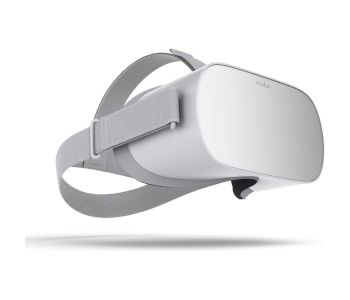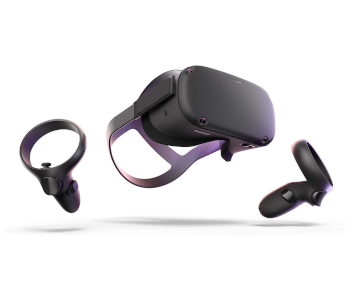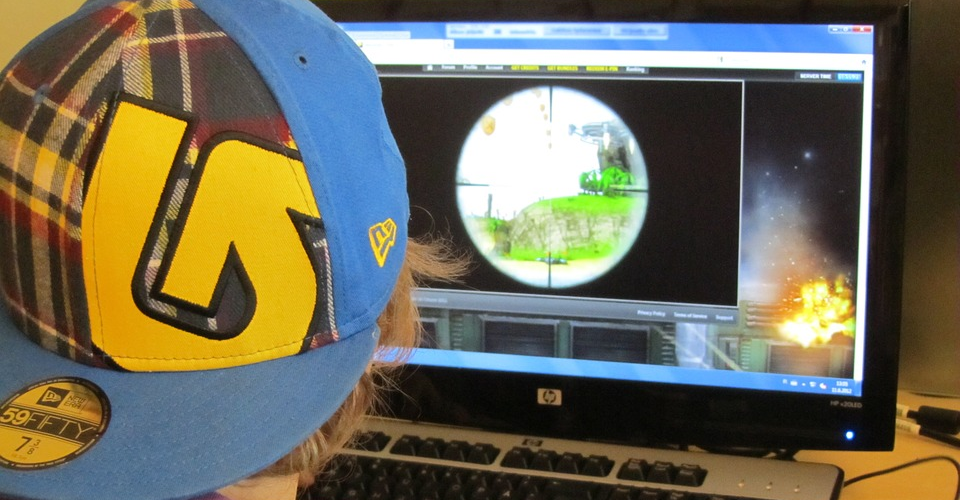Can My PC Handle VR Gaming? Specs and Requirements
Gaming with a monitor and standard mouse and keyboard inputs is a time-honored tradition. In other words, it’s starting to become old-fashioned. VR gaming seems like the cool new thing nowadays, and we think that it won’t be long before it becomes the new norm.
In most cases, VR gaming is done using a headset hooked up to a PC. It’s easy to see how resource-intensive VR gaming can be. After all, VR games have to render so much more graphical assets than a standard video game. If you’ve always wondered if your current PC can handle VR gaming, or if you’re planning of building a gaming rig from scratch, then read on for some of our recommended specs.
What makes VR gaming so resource-intensive?
Gaming has always been one of the biggest resource hogs for any type of PC or console, but what is it about VR gaming that makes it such an overwhelming feat? Let’s break down what does into a standard VR game:
1. Dual lens projection
![]()
Games are naturally graphic-intensive, especially in this era of gaming when developers are attempting to make their games more visually pleasing than ever. In a standard game, the PC only needs to output the video display to a monitor – nothing too complicated.
However, a VR game needs to have two displays: one each of your eyes. The visual outputs to each lens are also somewhat different from each other to create a stereoscopic image that tricks your eyes into seeing depth in what is, otherwise, a flat image.
In the case of fast-paced games, high-resolution graphics are even coupled with super-fast rendering. Framerate drops are particularly disliked when it comes to gaming, and VR games are no exception. If a game requires quick reactions form the player, any drops in framerate can easily ruin the experience.
2. Multiple inputs

VR games typically require the use of handheld controllers, particularly those that come bundled with VR headsets. These controllers do not only contain rudimentary buttons for quick user input, but their position and movement are also tracked in 3D space to allow the player to interact with the 3D environment.
While handheld controller inputs are nothing new, there is an extra dimension of interactivity that may seem invisible to many users. VR headsets typically come with an array of sensors such as gyroscopes, accelerators, and cameras that help the game track the movement and position of the user’s head. This allows you to freely look around the VR environment with three or six degrees of freedom.
A gaming PC that plays VR games needs to process simultaneous input from both the controllers and the sensors of the headset and translate them to in-game actions with minimal latency. This is a huge task, and how well the gaming PC handles it is crucial in defining how good the VR gaming experience is.
3. Multiple peripherals

Aside from the headset, a VR gaming platform can have a lot more accessories than you would expect. Aside from the usual handheld controllers, you may want to play a game that makes use of other controller types such as steering wheels or gloves. These peripherals typically require USB 3.0 ports, so you’ll need to make sure that you have enough on your gaming PC build. Don’t forget that you’ll probably still need to use your gaming PC for other activities, so make sure that you will still have enough ports for a mouse, keyboard, and an external storage device.
Despite the seeming complexity of building a PC for VR gaming, the good news is that most VR headsets come with a minimum or recommended specs for the experience that they offer. Of course, you have the option of getting more powerful hardware than what the manufacturers offer.
Anyone who’s ever been into PC gaming knows that regular upgrades are inevitable. By going for more powerful alternatives, you can future-proof your machine – at least for the next few years.
For the next sections, we’ll look at the hardware recommendations from two of the top brands in VR headset gaming: Oculus Rift and HTC Vive. We’ll also provide our own budget, premium, and best-value recommendations to give you options according to how much you’re willing to spend.
Graphics
The most critical component in your build, a good graphics card or GPU will ensure that your PC can render the high-resolution graphics that VR gaming requires at an acceptable framerate. Although both Oculus and HTC have released recommended specs for their flagship headsets, it is worth noting that different games can also have different requirements. Thus, there’s certainly merit in getting the best GPU that your budget can afford, as it ensures that you get a smooth experience no matter which VR game you load up.
| Oculus Rift | NVIDIA GTX 1060 or AMD Radeon RX 480 |
| HTC Vive | NVIDIA GTX 1060 or AMD Radeon RX 480 |
| Budget | Radeon RX 750 |
| Premium | GeForce GTX 1080 |
| Best value | GeForce GTX 1070 |
Both HTC and Oculus recommend GPUs equipped with either NVIDIA GTX 1060 OR AMD RX 480 chipsets, both of which costs somewhere between $250 to $300 and have been designed with VR gaming in mind. If you’re on a budget, you can settle for a Radeon RX750 chipset, which is a little on the low-end but should perform well enough for less graphics-intensive gaming. You should be able to buy this budget option for less than $200.
If you are willing to splurge for a high-quality graphics card, then we highly recommend the GeForce GTX 1080 chipset. This is a very powerful graphics card which should be able to handle everything that the current generation of VR gaming can offer, as well as the next few generations. At $500 to $600, getting a GTX 1080 GPU may be a huge investment, but it also means that you won’t be needing to upgrade for a couple of years.
If you aren’t exactly rolling in cash, we think that the best value-for-money GPU that you can get today is the GeForce GTX 1070, which should cost you just a bit above $400. This GPU should be powerful enough to handle all of the games available this generation at the highest graphics settings. This particular model from EVGA has solved many of the issues with overheating that previous GTX 1070 cards suffered, which means that it requires less power for cooling.
Processor
VR games are much less picky when it comes to CPUs, but you will still need a processor with enough cores and cache allotments to handle the rapid input and output requirements of VR gaming. This becomes more important if you intend to go online and play multiplayer VR games.
| Oculus Rift | Intel Core i5 4590 or AMD Ryzen 1500X |
| HTC Vive | Intel Core i5 4590 or AMD Ryzen 1500X |
| Budget | Intel Premium G4600 |
| Premium | AMD Ryzen 5 1600X |
| Best value | AMD Ryzen 5 1600 |
Both Oculus and HTC recommend the fourth generation i5 4590 CPUs, which shouldn’t set you back more than $200. These four-core or four-thread processors are designed for multitasking and are powerful enough to handle the visual rendering requirements of all types of gaming, including VR.
The recommended CPUs for both Oculus and HTC are already pretty cheap, so we don’t recommend stepping down any further. However, if you’re really strapped for cash, then the only cheap alternative we can suggest is an Intel Premium G4600 processor. It’s only a dual-core processor, so multiplayer gaming or games with detailed visual assets could prove to be a challenge, but this processor should perform well enough for most casual VR games. It also costs less than $100.
For a truly premium alternative, then we highly recommend the AMD Ryzen 5 1600X. This six-core processor has a 16-MB cache and is equipped with the intelligent ‘Zen+’ architecture. You can step down to a Ryzen 5 1600 if you’re looking for better value.
The thing about these processors is that their prices don’t differ by much – you’re not likely to spend more than $200 for a good CPU. If you have the budget to spare, then we recommend going for the best CPU that you can afford.
Video output and other ports
VR headsets connect to your gaming PC via video output, but you’re bound to get a few additional peripherals that can greatly enrich your VR gaming experience. When picking a motherboard, you’ll need to take stock of just how much hardware you’ll need to plug into your PC.
| Oculus Rift | HDMI 1.3, three USB 3.0 ports, one USB 2.0 port |
| HTC Vive | HDMI 1.4 or DisplayPort 1.2, 1 USB 2.0 port |
| Recommended | HDMI 2.0, three USB 3.0 ports, one USB 2.0 port |
HTC Vive requires the slightly upgraded HDMI 1.4 interface, which supports 4K video resolution at up to 30 Hz. In any case, HDMI 1.3 and 1.4 came out before or at the onset of 4K resolution and have been around for at least a decade. Nowadays, HDMI 2.0 ports are pretty standard and should be your minimum.
When it comes to USB ports, you will certainly want to have as many as possible. A USB 3.0 interface is vastly preferred for faster data transfer rates, which can come in handy if you’re playing games that require quick reactions. You can, of course, simply plug and unplug your PC’s peripherals as needed.
RAM
VR gaming doesn’t require RAM beyond what is typically required for old-fashioned gaming. In fact, the HTC Vive only requires 4GB of RAM, which is already standard even for non-gaming PCs.
| Oculus Rift | 8GB DDR4 |
| HTC Vive | 4GB or more |
| Recommended | 16GB DDR4 |
While having an 8GB RAM is perfectly fine if you’re on a budget, and should deliver a satisfactory gaming experience, upgrading to 16GB doesn’t require a huge additional expense. An 8GB DDR4 only costs around $40, while a 16GB option costs around twice as much. In the grand scheme of things, RAM is one of the cheapest parts of building a gaming PC, so we recommend spending a little bit extra for a palpable boost in performance.
Storage
How much storage you need in your gaming PC depends on how many games you intend to have installed and how much space these games will take up. While there’s an element of personal preference involved, you also have to keep in mind that more advanced VR games will inevitably have larger file sizes.
| Oculus Rift | Seagate Barracuda 1TB HDD |
| HTC Vive | No recommendations |
| Recommended | Crucial MX500 250TB SSD and Seagate Barracuda 1TB HDD |
Oculus and HTC only recommend a minimum 1 TB of local storage space for VR gaming using their respective headsets. This isn’t much nowadays and is a pretty standard storage space for PCs, gaming or otherwise.
If you’re looking for a performance boost and have the cash to spare, then we recommend adding an SSD for a dual-drive setup. Since SSDs can run up to 10x faster than an HDD, system files stores in an SSD can be read faster and can greatly enhance the overall performance of any PC. SSDs are quite expensive, however, so we still recommend pairing it with a budget-friendly HDD for bulk storage of non-system essential files.
Final thoughts
VR gaming extends the capabilities of your gaming PC and places you in a VR environment that is much more immersive and interactive than any game that you play using your standard PC monitor. While most high-end gaming PCs can handle VR gaming just fine, building your own gaming PC from scratch can be a pretty big undertaking.
The good news is that VR gaming isn’t as hardware-intensive as many people might think. In fact, you can probably get by with a budget PC gaming rig that costs less than $750. There is still, of course, a lot of merit in building a gaming PC made with high-end parts as it assures much better graphics performance, lower latency, and a capability to handle next-generation VR games.

